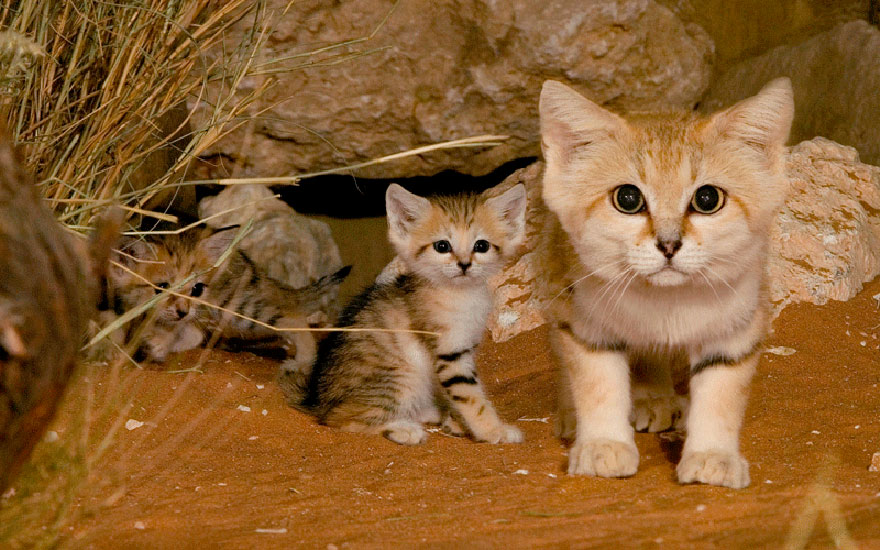
Sand Cats: Where The Adults Are Kittens And The Kittens Are Also Kittens
Sand cats are the Peter Pan of felines: they retain a kitten-like appearance their whole lives, giving the impression that they never grow up. Although they live in the desert Areas of North Africa, Arabia, Central Asia, and Pakistan, they are considered near threatened due to the illegal pet trade and sport hunting.
These cats are well adapted to their harsh environment. They can survive in temperatures between −5 °C (23 °F) to 52 °C (126 °F) and are able to survive for months on the water in their food. Unfortunately, a recent study indicated that only 61% of sand cats born in captivity live to day 30, primarily due to maternal neglect; they are also prone to various respiratory illnesses which makes them unsuitable as pets.
(h/t: thedodo)
Image credits: adremeaux
Image credits: John Jones
Image credits: home_77Pascale
Image credits: Big Cat Rescue
Image credits: goodnewsanimal
Image credits: Big Cat Rescue
Image credits: makhalifa
Image credits: surfingbird
Image credits: Ami211
Image credits: Tambako
Image credits: Mark Baldwin
Image credits: mellting
Image credits: Tambako
305Kviews
Share on Facebook"Unfortunately, a recent study indicated that only 61% of sand cats born in captivity live to day 30, primarily due to maternal neglect; they are also prone to various respiratory illnesses which makes them unsuitable as pets." Why is this unfortunately? I think it is great.. that way humans won't keep them as pets like that crazy fox lady does.. They belong in the wild and should do so. Not in cages in zoo's and with sick people that want a different kind of pet than the neighbor has..
It's unfortunate because captive breeding is one of the best hopes for continuing the species dumdum.
Load More Replies...There was an interesting article in National Geographic Magazine a few years ago about selective breeding to domesticate foxes in Russia. They documented what changes in appearance and behavior occurred with each generation. Domestication is not just behavior modification; it makes genetic changes. A truly domesticated animal is not the same as its wild cousin, just as a German shepherd is not the same as a wolf. Humans have domesticated many species for our own purposes, and I have no problem with that. But a wild animal rarely makes a good pet, and domestication does not preserve the original genome. Zoos try to maintain the original genetics, but a manmade environment does not teach survival skills and it's very tricky (though not impossible) to transition zoo-raised animals back to the wild. Ideally, we need to preserve the wild habitat and stop killing wild animals for stupid human reasons.
"Unfortunately, a recent study indicated that only 61% of sand cats born in captivity live to day 30, primarily due to maternal neglect; they are also prone to various respiratory illnesses which makes them unsuitable as pets." Why is this unfortunately? I think it is great.. that way humans won't keep them as pets like that crazy fox lady does.. They belong in the wild and should do so. Not in cages in zoo's and with sick people that want a different kind of pet than the neighbor has..
It's unfortunate because captive breeding is one of the best hopes for continuing the species dumdum.
Load More Replies...There was an interesting article in National Geographic Magazine a few years ago about selective breeding to domesticate foxes in Russia. They documented what changes in appearance and behavior occurred with each generation. Domestication is not just behavior modification; it makes genetic changes. A truly domesticated animal is not the same as its wild cousin, just as a German shepherd is not the same as a wolf. Humans have domesticated many species for our own purposes, and I have no problem with that. But a wild animal rarely makes a good pet, and domestication does not preserve the original genome. Zoos try to maintain the original genetics, but a manmade environment does not teach survival skills and it's very tricky (though not impossible) to transition zoo-raised animals back to the wild. Ideally, we need to preserve the wild habitat and stop killing wild animals for stupid human reasons.

 Dark Mode
Dark Mode 

 No fees, cancel anytime
No fees, cancel anytime 








































176
44